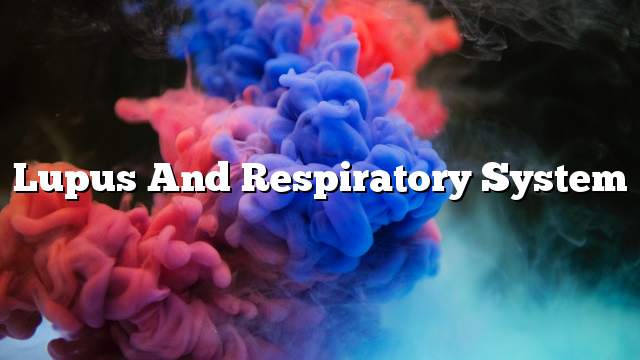Lupus and respiratory system
The lungs and respiratory tract also have a share in the disease. Pleurisy may include pleural effusion. The patient feels chest pain and difficulty breathing. It can lead to lung fibrosis.
Pulmonary embolism, pulmonary hemorrhage, pulmonary arterial pressure, pulmonary embolism, pulmonary embolism, pulmonary embolism,
(pulmonary hypertension). The patient may have regular symptoms (pain in the chest and difficulty in the breath) as well as blood when coughing.
The patient may complain of inflammation of the lungs with high temperature, difficulty in breath and pain
• SLE is an autoimmune disease that affects connective tissue, thus affecting many of the body’s organs, including joints, skin, nervous system, kidneys, heart and lungs.
• A disease that affects females more than males, and peaks in the second and third decades of age, and spreads in Spain, Italy and the Caribbean.
• The most important factors that lead to the disease is the genetic predisposition of the infection in addition to exposure to antigens and the formation of antibodies and immune compounds that attack the tissues of the body and cause inflammation.
The symptoms and signs of the disease vary according to the affected body, and the symptoms and signs of the joints and skin are the most common is the arthritis and the emergence of skin rash on areas exposed to the sun, and the injury of the nervous system is convulsions and headaches in addition to the change of mental state of mental disorders such as psychosis and depression. The injury of the kidneys is kidney inflammation or nephrotic syndrome, and lung injury is mainly in the inflammation of the membrane of the lungs and resulting in the leakage, and the heart is the inflammation of the membrane surrounding the heart, and inflammation of the heart muscle and resulting in heart deficit and irregularity in Heart rate, heart attack inflammation.
• Diagnosis is the occurrence of four or more of the 11 criteria set by the American College of Rheumatology, and the criteria are based on the clinical examination of the patient in addition to laboratory tests, which include examination of blood cells and antibodies.
• The advice to be given in the case of illness is to identify the patient and his family disease and side effects of medicine, avoid exposure to the sun and ultraviolet radiation and the use of sun protectors, and avoid overcrowded places for infection, and women should avoid contraceptive pills to prevent deterioration of the situation.
• Treatment includes anti-inflammatories and topical analgesics, and the use of steroid, the main treatment of the disease in addition to the use of immunosuppressants, especially in active cases of the disease. Antimalarial agents and biological agents are also used in this disease. Intravenous antibodies are used to exchange blood plasma in cases of bleeding in the lungs.
• Alternative medicine treatment using flax seeds, fish oils and omega-3, the use of Chinese herbs, the use of herbs rich in gamma linolenic acid such as spring flower oil and raisin oil. Avoid fatty meat and avoid peanuts and milk.
